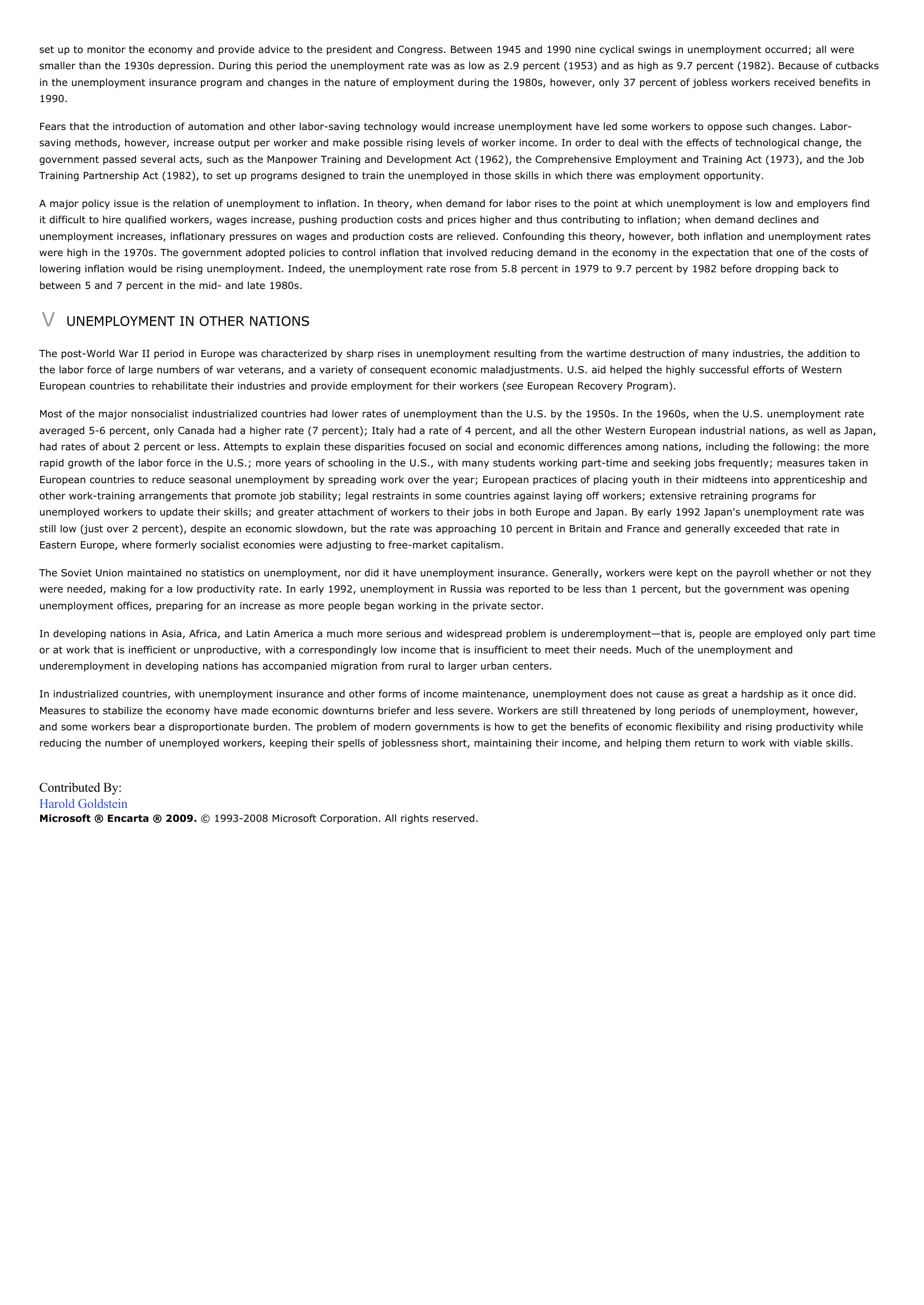Unemployment.
Publié le 10/05/2013

Extrait du document
«
set up to monitor the economy and provide advice to the president and Congress.
Between 1945 and 1990 nine cyclical swings in unemployment occurred; all weresmaller than the 1930s depression.
During this period the unemployment rate was as low as 2.9 percent (1953) and as high as 9.7 percent (1982).
Because of cutbacksin the unemployment insurance program and changes in the nature of employment during the 1980s, however, only 37 percent of jobless workers received benefits in1990.
Fears that the introduction of automation and other labor-saving technology would increase unemployment have led some workers to oppose such changes.
Labor-saving methods, however, increase output per worker and make possible rising levels of worker income.
In order to deal with the effects of technological change, thegovernment passed several acts, such as the Manpower Training and Development Act (1962), the Comprehensive Employment and Training Act (1973), and the JobTraining Partnership Act (1982), to set up programs designed to train the unemployed in those skills in which there was employment opportunity.
A major policy issue is the relation of unemployment to inflation.
In theory, when demand for labor rises to the point at which unemployment is low and employers findit difficult to hire qualified workers, wages increase, pushing production costs and prices higher and thus contributing to inflation; when demand declines andunemployment increases, inflationary pressures on wages and production costs are relieved.
Confounding this theory, however, both inflation and unemployment rateswere high in the 1970s.
The government adopted policies to control inflation that involved reducing demand in the economy in the expectation that one of the costs oflowering inflation would be rising unemployment.
Indeed, the unemployment rate rose from 5.8 percent in 1979 to 9.7 percent by 1982 before dropping back tobetween 5 and 7 percent in the mid- and late 1980s.
V UNEMPLOYMENT IN OTHER NATIONS
The post-World War II period in Europe was characterized by sharp rises in unemployment resulting from the wartime destruction of many industries, the addition tothe labor force of large numbers of war veterans, and a variety of consequent economic maladjustments.
U.S.
aid helped the highly successful efforts of WesternEuropean countries to rehabilitate their industries and provide employment for their workers ( see European Recovery Program).
Most of the major nonsocialist industrialized countries had lower rates of unemployment than the U.S.
by the 1950s.
In the 1960s, when the U.S.
unemployment rateaveraged 5-6 percent, only Canada had a higher rate (7 percent); Italy had a rate of 4 percent, and all the other Western European industrial nations, as well as Japan,had rates of about 2 percent or less.
Attempts to explain these disparities focused on social and economic differences among nations, including the following: the morerapid growth of the labor force in the U.S.; more years of schooling in the U.S., with many students working part-time and seeking jobs frequently; measures taken inEuropean countries to reduce seasonal unemployment by spreading work over the year; European practices of placing youth in their midteens into apprenticeship andother work-training arrangements that promote job stability; legal restraints in some countries against laying off workers; extensive retraining programs forunemployed workers to update their skills; and greater attachment of workers to their jobs in both Europe and Japan.
By early 1992 Japan's unemployment rate wasstill low (just over 2 percent), despite an economic slowdown, but the rate was approaching 10 percent in Britain and France and generally exceeded that rate inEastern Europe, where formerly socialist economies were adjusting to free-market capitalism.
The Soviet Union maintained no statistics on unemployment, nor did it have unemployment insurance.
Generally, workers were kept on the payroll whether or not theywere needed, making for a low productivity rate.
In early 1992, unemployment in Russia was reported to be less than 1 percent, but the government was openingunemployment offices, preparing for an increase as more people began working in the private sector.
In developing nations in Asia, Africa, and Latin America a much more serious and widespread problem is underemployment—that is, people are employed only part timeor at work that is inefficient or unproductive, with a correspondingly low income that is insufficient to meet their needs.
Much of the unemployment andunderemployment in developing nations has accompanied migration from rural to larger urban centers.
In industrialized countries, with unemployment insurance and other forms of income maintenance, unemployment does not cause as great a hardship as it once did.Measures to stabilize the economy have made economic downturns briefer and less severe.
Workers are still threatened by long periods of unemployment, however,and some workers bear a disproportionate burden.
The problem of modern governments is how to get the benefits of economic flexibility and rising productivity whilereducing the number of unemployed workers, keeping their spells of joblessness short, maintaining their income, and helping them return to work with viable skills.
Contributed By:Harold GoldsteinMicrosoft ® Encarta ® 2009. © 1993-2008 Microsoft Corporation.
All rights reserved..
»
↓↓↓ APERÇU DU DOCUMENT ↓↓↓







